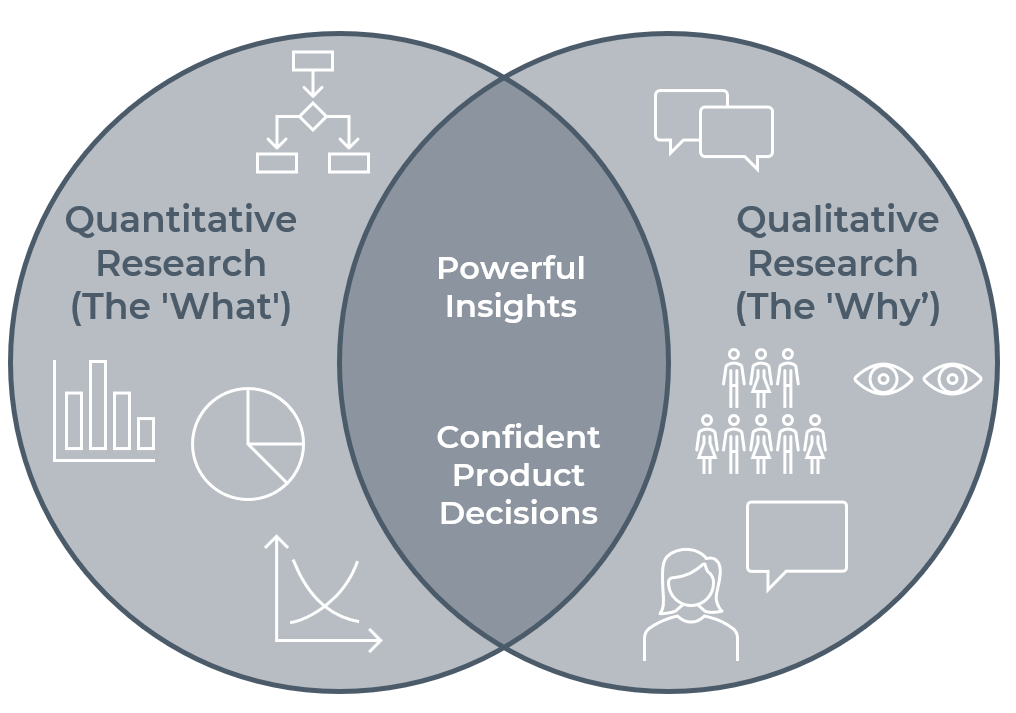To build a successful product, you need to answer two fundamental questions about your users: What are they doing? And why are they doing it? Answering only one of these questions gives you a dangerously incomplete picture. The most powerful product decisions are made by blending two distinct types of user research: quantitative and qualitative.
Understanding the difference between these methodologies is the first step toward a mature research strategy. As a core part of our user research services, Cardinal Peak combines both approaches to provide a complete, 360-degree view of the user experience.
Figure 1. The most powerful product insights are found at the intersection of quantitative data (the ‘what’) and qualitative research (the ‘why’).

Contents
Quantitative Research: Discovering the “What”
Quantitative research is all about numbers and measurable data. It provides objective, statistical insights into user behavior at scale. This is the data that tells you what is happening within your product.
Common methods include:
- Web and product analytics (e.g., Google Analytics)
- A/B testing results
- Surveys with closed-ended questions
- Success rates and time-on-task from unmoderated usability tests
Quantitative data is essential for identifying trends and pinpointing problem areas. For example, it might tell you that “75% of users abandon the checkout process on the payment screen.” This is a critical piece of information, but it leaves one important question unanswered.
Qualitative Research: Uncovering the “Why”
Qualitative research is designed to uncover the “why” behind the numbers. It deals with observations, motivations, and the context of a user’s experience. It’s how you get the rich, human story that data alone can’t provide.
Common methods include:
- One-on-one user interviews
- Moderated usability testing
- Open-ended survey questions
- Ethnographic studies
Continuing our example, qualitative research would allow us to discover why 75% of users are abandoning the checkout. Through a series of moderated user tests, we might discover that users don’t trust the page because it’s missing security logos, or that the “apply discount” field is confusing. This is the crucial, actionable insight that quantitative data alone could not provide.
The Power of a Blended Approach
The most effective UX research strategies don’t choose between quantitative and qualitative methods; they integrate them. The process often looks like this:
- Start with Quantitative Data: Identify a problem area (e.g., a drop-off in analytics).
- Use Qualitative Research: Dig deeper to understand the cause of the problem (e.g., user interviews reveal confusion).
- Implement a Solution: Redesign the confusing user interface based on the qualitative insights.
- Measure with Quantitative Data: A/B test the new design to measure its impact on the conversion rate.
This cycle of blending the “what” and the “why” is the engine of continuous improvement.
Conclusion: A Complete Picture for Confident Decisions
Relying on only one type of research can lead to flawed conclusions. By blending quantitative data to identify what’s happening and qualitative research to understand why it’s happening, you get a complete, actionable picture. This blended methodology, central to the user experience consulting provided by Cardinal Peak, is the key to making confident, evidence-based decisions that truly improve your product.
Build a Comprehensive Research Strategy
Don’t settle for an incomplete picture. Our experts blend quantitative and qualitative methods to give you a 360-degree view of your users. Let’s design a research plan that uncovers actionable insights and drives confident product decisions. Design your research plan.
User research is only valuable if it leads to action. Check out our blog post on our four-step process for turning raw user insights into a prioritized product roadmap that drives real business impact.
